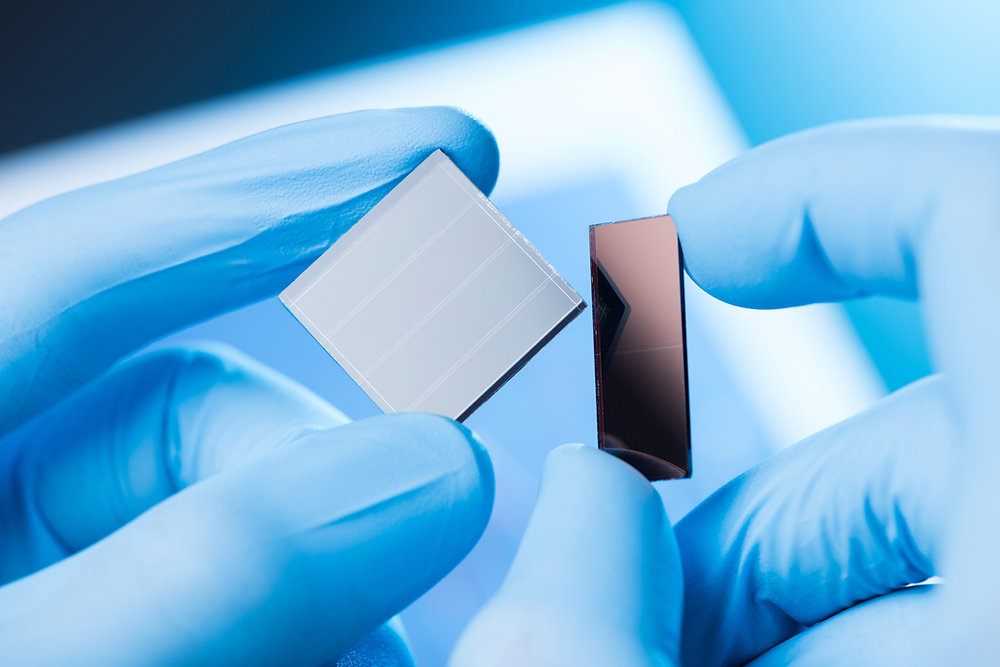
In recent decades, solar panel technology has evolved significantly, allowing for remarkable innovation. Advances include greater solar cell efficiency, the introduction of new and more abundant materials, advancements in manufacturing techniques, and flexible designs.
At GreenLancer, we’ve been at the forefront of the solar energy industry since 2013, witnessing the latest solar panel technology advancements firsthand. These new solar panel technologies are making solar photovoltaics more accessible and efficient than ever. Dive in to discover the latest solar technology trends shaping the PV industry.
Efficiency Skyrockets With New Solar Panel Technologies
Solar panel efficiency has seen remarkable advancements over the past two to three decades. In the early days, solar panels had a conversion efficiency of around 10%, meaning they could only convert about a tenth of the sunlight they captured into usable electricity. However, solar panel efficiency rates have increased dramatically thanks to continuous research, development, and technological breakthroughs.
Today, the latest solar panel technology advancements have led to panels achieving conversion efficiencies of over 20%, with some even reaching 25%. This means that solar PV systems can now convert nearly a quarter of the sunlight they capture into clean, renewable energy. These advancements continue to improve solar power’s efficiency and viability as a sustainable energy source.
Higher efficiencies make solar energy a more viable and attractive option for homeowners, businesses, and entire cities and reduce the space required for solar panels, allowing for greater electricity production from the same amount of sunlight. This increased efficiency has driven down the cost of solar power, making it more accessible to a broader audience and contributing to the widespread adoption of solar energy worldwide.
Manufacturing Advancements With Perovskite Solar Cells
As the cost of solar panels has significantly decreased over the past few decades, finding ways to reduce solar panel manufacturing costs further has become increasingly challenging. However, the affordability of solar modules is crucial for their widespread adoption. Today, nearly all solar panels are made from silicon. Thus, perovskite solar cells have emerged as a promising new solar panel technology due to their low production costs and high efficiency.
What Makes Perovskites Different?
Perovskites are a family of semiconductor materials with a specific crystal structure, named after the mineral perovskite. They can absorb a wide spectrum of sunlight, including both visible and near-infrared wavelengths, making them exceptionally good at converting sunlight into electricity. These properties give perovskites a significant edge in terms of performance potential.
What sets this new solar technology apart is its simple, low-temperature manufacturing process. Unlike silicon, which requires energy-intensive purification and processing, perovskite solar cells can be fabricated using inexpensive materials and solution-based coating methods—offering a path toward high-volume, low-cost production.
The Promise of Tandem Solar Cell Designs
One of the most exciting innovations in solar panel technology is the perovskite-silicon tandem solar cell. This hybrid design layers a perovskite cell on top of a conventional silicon cell, allowing each material to absorb different parts of the solar spectrum. Silicon captures long wavelengths, while perovskite captures shorter ones—together delivering much higher conversion efficiencies than silicon alone.
These tandem cells represent a major leap in the latest solar panel technology, as they’re beginning to exceed the practical efficiency limits of silicon-only modules.
Recent Announcements in Perovskite Research
-
LONGi Solar announced in November 2023 that its perovskite-silicon tandem solar cell hit an efficiency of 26.81%—a record-breaking milestone for this category of new solar panel technology.
-
In the U.S., researchers at the University of Colorado Boulder developed a new method for manufacturing perovskite cells using a technique that improves uniformity and performance consistency. This could be key to scaling production for commercial use.
As of early 2024, startups and major manufacturers around the world—including Oxford PV, Saule Technologies, and Tandem PV—are racing to commercialize these next-gen solar cells, with pilot lines already producing early-stage modules.
Remaining Challenges
Despite its promise, perovskite-based solar panel technology faces some hurdles. The primary concerns are:
-
Long-term stability: Perovskite materials can degrade when exposed to moisture, UV light, and heat.
-
Scalability: Transitioning from lab-scale efficiencies to consistent, high-yield manufacturing is complex.
However, advances in encapsulation, material composition, and tandem integration are rapidly addressing these barriers. If successful, perovskite solar cells could become a cornerstone of new solar technology, offering higher performance at a lower cost—especially important in markets looking to scale residential, commercial, and utility-scale solar projects.
Bifacial Solar Panel Technology Harnesses More Sunlight
Bifacial solar panels provide a unique advantage in solar energy generation by capturing sunlight from both the front and back of the module. This innovative design allows them to utilize reflected sunlight from various surfaces, such as the ground, water, or nearby structures, resulting in increased electricity yield.
Recent advancements in bifacial solar panel technology have significantly boosted their market share in the renewable energy industry. The global market for bifacial solar technology has experienced remarkable growth, driven by rising demand for clean energy, enhanced efficiency, reduced costs, and notable environmental advantages.
The versatility and efficiency of bifacial solar panel technology make them particularly valuable in applications ranging from commercial photovoltaic installations to large-scale solar farms, ultimately improving the economic viability of solar energy. Excitingly, researchers at the National Renewable Energy Laboratory (NREL) are currently exploring the development of bifacial perovskite solar cells, further enhancing the potential of this cutting-edge, next-generation technology.
Pros & Cons of Bifacial Solar Panel Technology
Although there are certainly advantages to using bifacial solar panels, there are also some drawbacks.
|
✅ Higher Energy Yield: Bifacial panels capture sunlight from both sides with this new solar technology, resulting in increased energy production compared to traditional PV panels. |
❌ Higher Cost: Bifacial panels, an advanced solar technology, are generally more expensive than traditional panels, making them a significant investment. |
|
✅ Durability and Longevity: Bifacial panels are built to withstand environmental conditions, and many models were top performers on the 2024 PVEL PV Module Reliability Scorecard. |
❌ Specialized Mounting: Bifacial panels require a different mounting system that allows light to reach both sides, which can increase installation complexity and cost. |
|
✅ Better Performance in Diffuse Light: Bifacial panels can generate energy from diffuse or reflected light, making them suitable for areas with cloudy or low-light conditions. |
❌ Aesthetic Considerations: The transparency of bifacial solar panel technology might not be visually appealing to some homeowners or commercial property owners. |
|
✅ Increased Energy Output in Some Environments: Bifacial panels perform exceptionally well in certain environments, such as snow-covered regions or areas with highly reflective surfaces. |
❌ Potential Dust and Dirt Accumulation: Because the backside of bifacial panels is exposed, dust and dirt will likely accumulate there, requiring more frequent cleaning and maintenance. |
|
✅ Versatile Applications: Bifacial solar panel technology can be used in various applications, including rooftops, carports, and floating solar farms. |
❌ Shadowing Effects: Bifacial panels are more susceptible to shadowing due to their dual-sided design. Proper installation and spacing are crucial to minimize this effect. |
Solar Panel Technology Becomes Flexible and Lightweight
Ongoing innovations in solar panel technology have led to the development of flexible and lightweight solar panels, reshaping how and where solar energy can be used. By leveraging cutting-edge materials like organic photovoltaics, perovskites, and ultra-thin silicon, researchers have created solar modules that are thin, bendable, and light enough to be installed in places where traditional rigid panels aren’t practical.
MIT researchers recently unveiled ultralight fabric solar cells—a major advancement in new solar panel technology. These solar cells are thinner than a human hair and can be laminated onto virtually any surface, from canvas to plastic. Despite weighing just one-hundredth of conventional glass-encased PV panels, they generate 18 times more power per kilogram, demonstrating impressive power-to-weight ratios. This breakthrough is a strong contender in the race to commercialize the latest solar panel technology for mobile and off-grid applications.
This new solar technology is particularly useful for portable solar solutions, wearable electronics, and emergency response kits. The flexible design makes it easy to conform to curved or uneven surfaces—like tents, vehicle roofs, drones, and even spacecraft. Researchers are also exploring textile-integrated PV, where solar fabrics could be used in jackets and backpacks to power small electronics.
In remote or off-grid locations, solar panel technology that is easy to transport and install can be a lifeline. Lightweight solar sheets can be rolled up, shipped compactly, and deployed in minutes—no racking or heavy hardware required. This flexibility is helping to expand solar access to areas with minimal infrastructure, offering a scalable and reliable source of clean energy.
Optimizing Renewable Energy with Energy Storage
In 2025, the integration of energy storage systems with solar panels is expected to witness significant advances and updates. One key area of focus is the development of more advanced battery technologies, such as lithium-ion and flow batteries, specifically designed for solar energy storage. These batteries offer higher energy density, longer lifespan, and improved charging and discharging capabilities, allowing for more efficient utilization of stored solar energy.
Advancements in battery management systems (BMS) are anticipated to play a significant role in the future of solar technology, providing better control and optimization of energy storage. These systems will enable users to maximize the use of stored solar energy based on demand, grid conditions, or time-of-use pricing, ultimately leading to cost savings and increased energy efficiency.
In addition to new solar technology advancements, integrating solar panels and energy storage systems is expected to benefit from improved governmental policies and regulations. Governments and utilities worldwide recognize the value and potential of energy storage in supporting renewable energy integration and grid stability. Therefore, 2025 is expected to see more favorable incentives and support programs for deploying solar-plus-storage systems, promoting widespread adoption in the clean energy industry.
Transparent Solar Panel Technology Has Aesthetic Appeal
One of the most striking innovations in solar panel technology is the development of transparent solar panels—a breakthrough that merges architectural design with renewable energy generation. Using advanced materials like transparent luminescent solar concentrators (TLSCs) or semi-transparent perovskite cells, this new solar panel technology allows surfaces such as windows, facades, and skylights to double as energy-harvesting devices without sacrificing visibility or light transmission.
Researchers at the U.S. Department of Energy’s National Renewable Energy Laboratory (NREL) have been exploring ways to optimize the balance between transparency and power output. While traditional PV modules prioritize maximum efficiency, transparent PV glass focuses on selective light absorption, typically capturing ultraviolet and near-infrared wavelengths, while letting visible light pass through. This makes it ideal for building-integrated photovoltaics (BIPV) where aesthetics and daylighting are just as important as energy production.
The integration of transparent solar panel technology brings a dual benefit: enhancing the visual and functional appeal of structures. From modern office towers to residential homes, windows embedded with this latest solar panel technology can help offset a building’s electricity demand while preserving natural light and unobstructed views.
Although still in early commercialization stages, transparent solar panels show promise in reducing urban energy consumption, particularly in high-rise buildings where window surface area far exceeds roof space. As new solar panel technology continues to evolve, transparent PV systems are expected to play a growing role in sustainable architecture and zero-energy building design.
Rise of Smart New Solar Panels Unlocks Efficiency & Performance
The increasing integration of smart solar panel technologies, including sensors and Internet of Things capabilities, is revolutionizing the solar industry with this new solar panel technology. This integration enables superior monitoring, maintenance, and optimization of solar panel performance, leading to enhanced efficiency and effectiveness.
By incorporating smart new solar panel technologies, the efficiency and lifespan of solar PV arrays are significantly boosted. This advancement promotes a more proactive and responsive method of generating solar electricity, laying the groundwork for a smarter new solar panel technology and interconnected energy infrastructure with improved performance and sustainability.
By leveraging data analytics and automation, smart solar panels can adjust their orientation, track sunlight, and address solar energy production issues proactively, ensuring maximum electricity output and solar PV system reliability. This integration of smart new solar technologies enhances the overall effectiveness of solar panels and paves the way for a more interconnected and intelligent energy ecosystem. With ongoing advancements, the deployment of smart solar panels holds great potential in driving the widespread adoption of renewable energy and accelerating the use of solar photovoltaic technology.
FAQs About Latest Solar Panel Technology Trends
Read on to learn answers to common questions about the latest advancements and innovations in new solar panel technology.
Which U.S. organizations are researching new solar panel technology?
NREL is a major national renewable energy research organization that is at the forefront of the latest solar panel technology research. NREL conducts studies in various areas, such as advanced PV materials, device design and testing, and solar PV manufacturing innovations.
Its research aims to improve solar cell conversion efficiencies and reduce the cost of PV technologies to make solar energy more accessible and cost-effective. Other national organizations involved in solar panel technology research include Sandia National Laboratories, a research facility focusing on developing advanced PV materials, devices, and systems for a sustainable energy future.
Many universities also research new solar panel technology. For example, Stanford University’s Global Climate & Energy Project provides funding for research into new technologies for clean energy and renewable resources, including solar power. The University of California, Berkeley, also has a dedicated solar energy research group, and its work has led to new solar cell technologies with higher efficiency. Also, the Massachusetts Institute of Technology (MIT) has a solar energy laboratory that researches various aspects of solar energy, such as new materials, devices, and system designs, to improve solar cell efficiency and cost.
In addition, some companies are conducting extensive research into developing and commercializing new solar panel technologies. For example, Oxford PV is a UK-based company specializing in developing and commercializing thin-film perovskite solar cells.
What are some of the new solar panel technology trends for 2025?
Emerging solar panel technology trends for 2025 include advancements in tandem and perovskite cells, which boost efficiency and energy output, along with the growing use of bifacial panels that capture sunlight on both sides. Smart inverters are also becoming more prevalent, enhancing energy management and integration with storage systems. Innovations in artificial intelligence and blockchain further streamline monitoring and optimize system performance.
These advancements in solar technology are driving greater efficiency, cost savings, and versatility in applications. As these trends grow, they are set to increase solar energy adoption across residential, commercial, and utility-scale projects.
How is blockchain technology used in the solar industry?
Blockchain technology is a distributed digital ledger system enabling secure, transparent, and decentralized energy trading in the solar industry with virtual power plants (VPPs). It allows peer-to-peer energy trading between consumers, producers, and system operators with no intermediaries, facilitating more efficient and reliable energy transactions.
This integration enhances the transparency and traceability of transactions in solar technology, promotes renewable energy adoption, and supports the management of distributed energy resources. Blockchain also advances microgrid operations, reduces transaction costs, and optimizes operations and maintenance within the solar industry.
Unlocking the Potential of New Solar Technology
As solar PV module technology evolves, renewable energy feasibility is rapidly increasing. Through enhanced efficiency, the integration of smart technologies, and advancements in materials and design, solar power is becoming an increasingly accessible and versatile energy source.
The latest solar panel technology advancements are reshaping how we think about energy and its role in modern life, positioning solar power as an essential part of the future of sustainable energy. By streamlining the permitting and engineering process, the United States can accelerate the transition to renewable energy sources and unlock a world of benefits for the environment and economy alike.
GreenLancer was created to empower solar energy contractors with the expertise required to overcome solar permitting and interconnection obstacles, accelerating the deployment of clean energy infrastructure. Create a GreenLancer account to begin shopping for solar design and engineering services, or complete the form below for more information.
Source link

